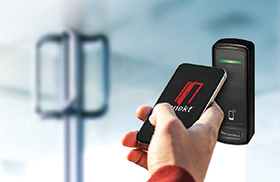

Farpointe Data has made it possible for access control system manufacturers, integrators and dealers to provide their customers with a broadened line of Conekt smartphone mobile access control products with multiple new customer-requested reader models.
“While typically, mobile-based access control uses smartcard technology, proximity still makes up a significant proportion of the card access credentials in use around the world,” reports Scott Lindley, general manager of Farpointe Data. “In many installed locations, proximity is doing the job it has been asked. However, many organisations would like to add the no-card convenience of mobile to their systems without having to add the extra expense of switching their entire proximity solution over to the smartcard technology. With the PCR series of Farpointe’s mobile Conekt proximity readers, they now have a more economical way to do so.
“As the acronym implies, a PIN can act as a form of identification,” Lindley adds. “It can also act as a form of verification, complementing a smartphone. This is because the PIN is something known only by the system and the user. For consumers using the smartphone and then keying in their PIN on the reader’s keyboard, heightened security can therefore be based on something the user has, a smartphone, plus something the user knows, a PIN. The PIN number is essentially as secure as the vigilance of the user.”
The new Conekt keypad readers from Farpointe include a keyboard that can be used to enter the PIN to create two-factor access control. This can provide stricter access to prescription drug cabinets or network server rooms. They can be installed indoors or out. Additionally, it is good security practice to consider installing keypad readers at perimeter doors, often a secured facility’s first line of defence. Farpointe’s Conekt keypad readers are ETL listed to the UL294 standard, Edition 7, US and C.
© Technews Publishing (Pty) Ltd. | All Rights Reserved.